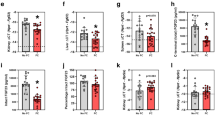Abstract
Trace element status is known to be altered in the diabetic state, although the factors affecting trace element homeostasis in this condition are not well understood. The authors examined the effects of a high fructose diet (40% wt:wt) vs a control diet on the copper (Cu), zinc (Zn), and iron (Fe) concentrations in the kidney, plasma, and red blood cells of islet transplanted (TX) and shamoperated (SHAM) rats. Male, Wistar Furth rats made diabetic by streptozotocin injection (55 mg/kg, iv) were given an intraportal islet transplant (1000 islets); control animals were shaminjected, shamoperated (SHAM). Rats within TX and SHAM groups were assigned to either a high fructose diet (40% fructose, 25% cornstarch, FR) or a purified control diet (33% cornstarch, 33% dextrose, CNTL) containing identical amounts of mineral mixture for a period of 6 wk. Kidney Cu concentration was significantly elevated among hyperglycemie TXCNTL rats (224 ± 25 nmol/g wet wt), but was markedly reduced in hyperglycemic TXFR rats (109 ± 14 nmol/g) relative to normoglycemic controls. This occurred in spite of similar levels of glucose, insulin (fed and fasted), insulin secretory capacity, body weight, and food intake in the TXCNTL and TXFR groups. Among the subgroup of rats with normal glucose levels post-TX, kidney Cu levels normalized and were unaffected by dietary treatment (normoglycemic TXCNTL = 60 ± 5 nmol/g; normoglycemic TXFR = 40 ± 2 nmol/g). Kidney Cu concentrations also were unaffected by fructose feeding in SHAM animals (CNTL, 60 ± 4 nmol/g and FR, 51 ± 5 nmol/g). Kidney Zn and Fe concentrations were similar among the treatment groups. Plasma and red blood cell (RBC) Cu, Zn, and Fe concentrations were also similar among the groups. Since fructose feeding led to a substantial reduction of kidney Cu concentrations in the presence of hyperglycemia, the authors suggest that this model can be useful in examining effects of altered kidney Cu accumulation in the diabetic animal.
Similar content being viewed by others
References
M. L. Failla, Trace element metabolism in the chemically diabetic rat,Biol. Trace Element Res. 5, 275–284 (1983).
M. H. Oster, J. Y. Uriu-Hare, C. L. Trapp, J. S. Stern, and C. L. Keen, Dietary macronutrient composition influences tissue trace element accumulation in diabetic Sprague-Dawley rats,Proc. Soc. Exp. Biol. Med. 207, 67–75 (1994).
M. L. Failla and R. A. Kiser, Altered tissue content and cytosol distribution of trace metals in experimental diabetes,J. Nutr. 111, 1900–1909 (1981).
M. L. Failla and C. Y. R. Gardell, Influence of spontaneous diabetes on tissue status of zinc, copper, and manganese in the BB Wistar rat,Proc. Soc. Exp. Biol. Med. 180, 317–322 (1985).
R. M. Walter, J. Y. Uriu-Hare, K. Lewis Olin, M. H. Oster, B. D. Anawalt, J. W. Critchfield, and C. L. Keen, Copper, zinc, manganese and magnesium status and complications of diabetes mellitus,Diabetes Care 14, 1050–1056 (1991).
R. D. Rohn, P. Pleban, and L. L. Jenkins, Magnesium, zinc and copper in plasma and blood cellular components in children with IDDM,Clinica Chimica Acta 215, 21–28 (1993).
N. Car, A. Car, M. Granic, Z. Skrabalo, and B. Momcilovic, Zinc and copper in the serum of diabetic patients,Biol Trace Element Res. 32, 325–329 (1992).
T. Isbir, L. Tamer, A. Taylor, and M. Isbir, Zinc, copper and magnesium status in insulin-dependent diabetes,Diabetes Res. 26, 41–45 (1994).
B. L. O’Dell, Fructose and mineral metabolism,Am. J. Clin. Nutr. 58(Suppl.), 771S-778S (1993).
P. M. Gerrits, and E. Tsalikia, Diabetes and fructose metabolism,Am. J. Clin. Nutr. 58(Suppl.), 796S-799S (1993).
R. C. Bell, E. A. Ryan, and D. T. Finegood, Consequences of high dietary fructose in the islet-transplanted rat with suboptimal B-cell mass,Am. J. Physiol. 270 (Endocrinol. Metab. 33), E292-E298 (1996).
B. W. Tobin, J. T. Lewis, D. Z. X. Chen, and D. T. Finegood, Insulin secretory function in relation to transplanted islet mass in STZ-induced diabetic rats,Diabetes 42, 98–105 (1993).
M. T. Clegg, C. L. Keen, B. Lonnerdal, and L. S. Hurley, Influence of ashing techniques on the analysis of trace element in animal tissue,Biol. Trace Element Res. 3, 107–115 (1981).
S. P. Osborne and M. L. Failla, Altered renal copper metabolism in the streptozotocin diabetic (STZ) rat,Fed. Proc. 41, 1088 (1982).
M. L. Failla, U. Babu, and K. Seidel, Use of immunoresponsiveness to demonstrate that the dietary requirement for copper in young rats is greater with dietary fructose than dietary starch,J. Nutr. 118, 487–496 (1988).
M. Fields, J. Holbrook, D. Scholfield, J. C. Smith Jr., and S. Reiser, Los Alamos Medical Research Group, Effect of fructose or starch on copper-67 absorption and excretion by the rat,J. Nutr. 116, 625–632 (1986).
G. Bellomo, J. P. Comstock, D. Wen, and R. L. Hazelwood, Prolonged fructose feeding and aldose reductase inhibition: effect on the polyol pathway in kidneys of normal rats,Proc. Soc. Exp. Biol. Med. 186, 348–354 (1987).
G. J. Van Den Berg, S. Yu, A. Van Der Heijden, A. G. Lemmens, and A. C. Beynen, Dietary fructose vs. glucose lowers copper solubility in the digesta in the small intestine of rats,Biol. Trace Element Res. 38, 107–115 (1993).
J. M. Smithgall, The copper-controlled diet: Current aspect of dietary copper restriction in management of copper metabolism disorders,J. Am. Diet. Assoc. 85, 609–611 (1985).
P. Faure, P. Y. Benhamou, A. Perard, S. Halimi, and A. M. Roussel, Lipid peroxidation in insulin-dependent diabetic patients with early retina degenerative lesions: effects of an oral zinc supplementation,Eur. J. Clin. Nutr. 49, 282–288 (1993).
J. Cunningham, M. Leffell, P. Mearkle, and P. Harmatz, Elevated plasma ceruloplasmin in insulin-dependent diabetes mellitus: evidence for increased oxidative stress as a variable complication,Metabolism 44, 996–999 (1995).
D. Guigiano, A. Ceriello, and G. Paolisso, Oxidative stress and diabetic vascular complications,Diabetes Care 19, 257–267 (1996).
Author information
Authors and Affiliations
Rights and permissions
About this article
Cite this article
Bell, R.C., Sakanashi, T.M., Keen, C.L. et al. High fructose intake significantly reduces kidney copper concentrations in diabetic, islet transplanted rats. Biol Trace Elem Res 61, 137–149 (1998). https://doi.org/10.1007/BF02784026
Received:
Revised:
Accepted:
Issue Date:
DOI: https://doi.org/10.1007/BF02784026




